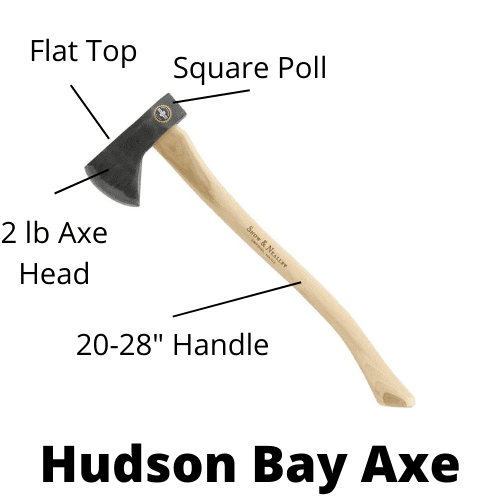A Hudson Bay axe has a 20 to 28-inch handle and features a 2 lb axehead with a flat top and a swept back design mainly used as an all-purpose camp axe.
There are hundreds of different axe types that are all suited for their own specific purposes going back hundreds of years. One style that has remained popular for several hundred years is the Hudson Bay Axe.
This axe falls in between a hatchet and a felling axe – I have found this makes it highly versatile and can do almost any task that an outdoorsman needs from it. Its unique design features and fascinating history make this one of my personal favorite axes.
In this article, I will explain the history of the Hudson Bay Axe, the design features that made it so popular, and the modern-day brands that you can find in your local hardware store.
Table of Contents
History of the Hudson Bay Axe
The name comes from the Hudson Bay Company, which dominated the fur trade in the Hudson Bay area and its drainage basin (that is, the rivers flowing into it) in modern-day northern Canada and some parts of the northern US. The Hudson Bay Company conducted business from 1670 into the 1800s.
French “trade axes” that traders sold to Native Americans in exchange for beaver pelts had no poll (the steel wrapped around the handle) and were usually of lower-quality steel, so the superior Hudson Bay axes became desirable tools for Native Americans and gained popularity among European settles.
The shape of the eye is essential, as the earliest trade axes had round eyes that were problematic for keeping the axe head secured to the handle. The Hudson Bay design improved to a teardrop-shaped eye to keep the axehead attached in the harsh environment for daily use.

Purpose
Hudson Bay axehead pattern axes were popular with fur traders, woodsmen, and native peoples. They were not meant to be used as felling axes. Instead, they were all-purpose camp axes good for limbing tree branches and cutting down small trees for building shelters, processing firewood, hunted-down big game, and so on. Users could adapt the handle length to their purpose – Hudson Bay pattern axeheads were mounted on both large and small handles, although the most popular sizes were in the 20 to 28-inch range.
Hudson Bay axes were handier than hatchets but lighter than big felling axes. Their flat polls allowed the user to drive wooden stakes with them or use them as a hammer if necessary.
The very reasons they were popular in the days of the fur trade is the same reason they are popular today. They are versatile, lightweight, extremely useful, and can be adapted to almost every purpose. The Hudson Bay Axe design is a favorite among outdoorsmen due to its key design features.
Features and Design
A few key features can summarize a Hudson Bay axe’s design:
- 2 lb axehead weight
- Tear drop shaped eye
- Flat-top of the axe head
- Square poll
- Swept-back design
- 20-28 inch handle length
You can see all of these features on the modern Snow and Neally axe in the image below. The flat-top axe head and square poll are particularly evident, along with the curved handle design.
These features were all designed for a specific purpose in mind – versatility and reliability. The Mediterranean axe design came with a circular eye which proved to be insecure in setting the axe head in the harsh environment of the frontier. The addition of a square poll, which the original trade axes didn’t have, improved the ability to hammer in wooden pegs.
Modern Hudson Bay Axes
The Hudson Bay axe design remains popular even in the 21st century. I would define this type of axe as a bushcraft axe due to its length and weight. They are ideal for camping because of their versatility – they are light enough for easy transport and the ability to cut kindling, but are heavy enough to fell small trees, and the flat poll allows for use as a hammer.
Some popular modern-day Hudson Bay axe brands include:
- Council Tool
- Snow and Neally
- Wetterlings
- Gransfors Bruk
- Marbles
- Hultafors
- Bahco
- Collins
You could also call a Hudson Bay Axe design a camp axe. Their flat poll is ideal for hammering in tent pegs and I find their size, particularly on the shorter end, to be ideal for campers. They can be carried easily into hard-to-reach locations and can accomplish any camping task from kindling to limbing.
Conclusion
The Hudson Bay Axe has a remarkable history throughout the Americas and remains popular in modern times. The design was improved from the Mediterranean design and has remained unchanged for several hundred years. This shows the benefits that these features have delivered. The Hudson Bay axe is exceptionally versatile and a favorite with bushmen and campers like myself.

